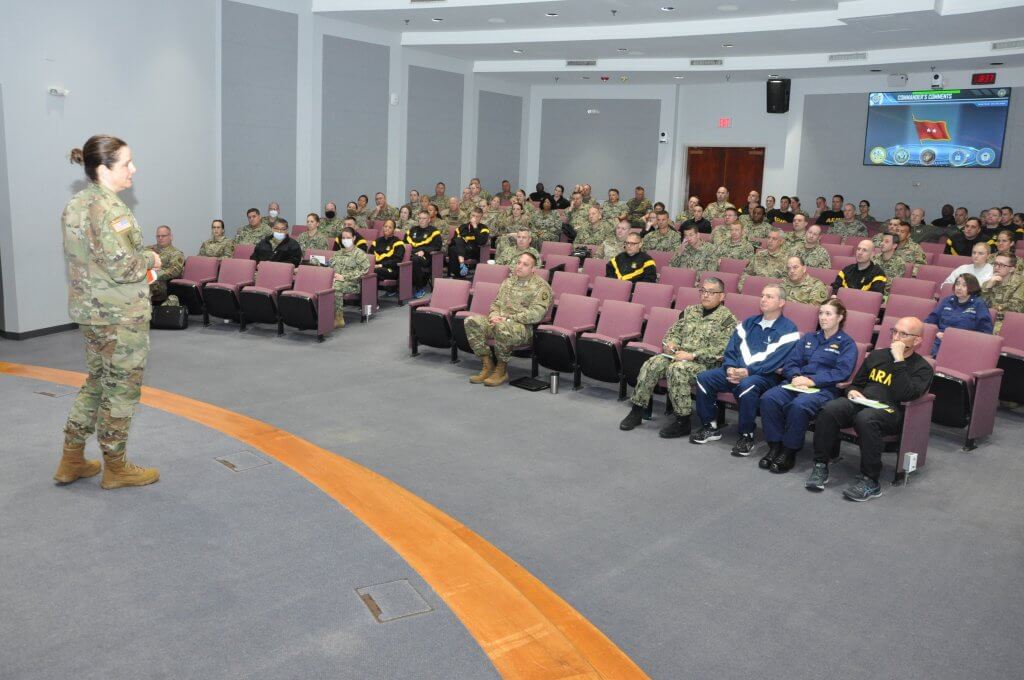Since arriving at U.S. Transportation Command in July 2021, Maj. Gen. Cheryn Fasano has been at the forefront of three large-scale events – COVID-19 mitigation and tracking; Operation Allies Refuge; and Russia’s invasion of Ukraine – while manning her first joint position.
“Coming into a COVID environment, rolling into OAR, transitioning into this new concept where we weren’t drilling every single month, bringing all that together seamlessly to the TRANSCOM directorates, that was really my big goal … to coordinate all that,” said Fasano, Joint Transportation Reserve Unit (JTRU) commander and mobilization assistant to TRANSCOM commander.
And, according to Fasano, JTRU’s involvement with Operation Allies Refuge – the U.S. evacuation of Afghans and U.S. citizens in the final days of the Afghanistan War – proved its value to TRANSCOM.
“That was a huge lift and required a lot of not just reservists within the JTRU but reserve forces from the Air Force side as well in how we provided that support,” Fasano, a two-star general, said. “So I think that was really solidified for those who had not seen that before, those here at TRANSCOM who had not seen that before, what we bring, what value we bring to TRANSCOM.”
The largest noncombatant evacuation operation, OAR saw TRANSCOM rescue 124,000 civilians from Kabul and 6,000 Americans, according to TRANSCOM data.
One of TRANSCOM Commander Gen. Jacqueline Van Ovost’s priorities is “ready now and in the future,” which Fasano said aligns with where she came from in the Army Reserve.
“The Army Reserve purely exists to provide trained and ready soldiers to the United States Army,” she said. “So that was an easy understanding for what Gen. Van Ovost needed from us.
“We need to have all our reservists ready if you’re called up at a moment’s notice like we were with OAR or Ukraine, that they’re ready to step into those roles without needing additional training or additional guidance or preparation in order to provide relevancy to the mission.”
RELATED: Joint Reserve Force leaders recount contributions to pandemic, DLA mission
While prepared to respond to Russia’s invasion of Ukraine earlier this year, Fasano said the actions weren’t as intense as OAR.
“Ukraine is a big deal in terms of [the Department of Defense] and what they strive to achieve, what does success mean to the DOD,” Fasano said. “In terms of TRANSCOM, because while we’re sending critical equipment and weapons to Ukraine, it’s not as intense as the number of aircraft that we needed to move … folks out of Afghanistan.”
TRANSCOM provided more than 450 flights in security assistance support to Ukraine, according to data as of May 10, compared to more than 250 Air Mobility Command aircraft and more than 330 C-17 missions (not to mention more than 400 commercial flights).
Still, Fasano said that when JTRU learned how much personnel would be requested, there were enough volunteers immediately.
“We were able to respond to that and seeing reservists who were so willing to step up yet again,” Fasano said. “So the third time in a year, third time in two years and say we understand the importance of TRANSCOM’s mission to the United States of America and allies and partners across the world, and we’re ready to step in at a moment’s notice. So that was pretty inspiring.”
Future TRANSCOM goals
One of Fasano’s goals is to get back into Turbo Challenge, TRANSCOM’s largest annual exercise that hasn’t been held since 2020. The exercise includes thousands of airmen trained in “combatant command coordination, command and control, and capabilities and functions integration” who respond on a global scale “when diplomatic efforts fail, according to the Team McChord website.
She said she would like to see what it would look like with the “entire JTRU and augmentation of TRANSCOM.”
“So our ACRC initiative and the training we’re doing through the directorates, how does that all play out in something that replicates a real world situation,” she said. “I don’t know if we’re going to get there just because there are other things that have happened. So COVID environment, OAR happened right when we were supposed to have it … [But] I would love to see that all-in JTRU support.”
Leadership for the future
Having recently attended the commissioning ceremony for cadets from her alma mater, Indiana University-Purdue University (IUPUI), Fasano highlighted the importance of mentorship with the cadets.
There were “two key points” in her career where had someone not offered her advice, she might be in a different position.
As a senior first lieutenant unsure of what to do, Fasano said a major sat down with her on day 1 and asked for her plan. When she relayed that she didn’t know, he gave her the next steps to take.
“He laid everything out for me. He gave me a clear path and had he not done that, I probably would have completed my career as a captain,” she said.
Then as a colonel, she had a similar situation happen.
Being involved in a commissioning or promotions ceremony is “always really an honor,” for Fasano. Not to mention being involved at her alma mater.
“It was the 40th commissioning class coming out of that school, and we talk about the seeing what’s possible,” Fasano said. “So they see I’m coming out of this program and here’s a two star who came out of the program, so what’s possible in the future.”
Fasano commissioned as a second lieutenant in May 1989 through IUPUI’s ROTC program. She’s among the 80% of currently serving military who has a family history of service. Her father enlisted in the Army in 1961, attended West Point and was commissioned in 1967.
In 1979, Fasano’s mother received her direct commission in the Army, went on active duty for three years, then transitioned to a part-time reservist role. She retired as a colonel at 60 years old. Her father retired 20 years after his commission.

